The True Origination and Meaning of SOS Revealed
Harmony asks “Do the letters in the term SOS represent three words? If so, could you let me know what they are?” Thanks to Neal McEwen for allowing us to use some information from his articles “SOS”, “CQD” and the History of Maritime Distress Calls.
There is much mystery and misinformation surrounding the origin and use of maritime distress calls. Most of the general populace believes that “SOS” signifies “Save Our Ship.” Casual students of radio history are aware that the use of “SOS” was preceded by “CQD.” Why were these signals adopted? When were they used?
History of the SOS Signal
Though the SOS signal is well known in most circles these days, its original use was strictly maritime. The International Radio Telegraphic Convention chose the SOS signal in 1906. This came a year after it had become the choice of the German government for maritime emergencies.
Many people in the general population are surprised to learn that SOS was replaced by the Global Maritime Distress and Safety System back in 1999. Of course a traditional SOS is still recognized and will be responded to as normal if received by the Coast Guard or other emergency services, but it is technically an outdated method of requesting aid.
What Does SOS Stand For?

Believe it or not, absolutely nothing.
If you’ve been wondering “what does SOS stand for?” The truth is that it doesn’t stand for anything. The Morse Code is a line of three dots, three dashes, and three more dots. It’s designed to be easy to communicate to others. The pattern is simple, recognizable, hard to mistake for anything else and easy to remember. It just so happens that three dots also means “S” and three dashes means “O” in the Morse Code alphabet. It’s just one of those convenient accidents.
Or is it? The SOS Morse code conveniently means nothing else, so its messages can’t possibly get confused either, which is an added benefit to use it which can reduce communication errors. How about that?
How SOS Was Developed for Maritime Use
The practical use of wireless telegraphy was made possible by Guglielmo Marconi in the closing years of the 19th century. Until then, ships at sea out of visual range were very much isolated from shore and other ships. The wireless telegraphers used Morse Code to send messages. Morse Code is a way of “tapping” out letters using a series of dots (short signals) and dashes (long signals). Spoken, short signals are referred to as “dih” and long signals are referred to as “dah”. The letter “A” is represented by a dot followed by a dash:
By 1904 there were many trans-Atlantic British ships equipped with wireless communications. The wireless operators came from the ranks of railroad and postal telegraphers. In England a general call on the landline wire was a “CQ.” “CQ” preceded time signals and special notices. “CQ” was generally adopted by telegraph and cable stations all over the world. By using “CQ,” each station receives a message from a single transmission and an economy of time and labor was realized. Naturally, “CQ,” went with the operators to sea and was likewise used for a general call. This sign for “all stations” was adopted soon after wireless came into being by both ships and shore stations.
In 1904, the Marconi company suggested the use of “CQD” for a distress signal. Although generally accepted to mean, “Come Quick Danger,” that is not the case. It is a general call, “CQ,” followed by “D,” meaning distress. A strict interpretation would be “All stations, Distress.”
At the second Berlin Radiotelegraphic Conference 1906, the subject of a danger signal was again addressed. Considerable discussion ensued and finally SOS was adopted. The thinking was that three dots, three dashes and three dots could not be misinterpreted. It was to be sent together as one string.
The Marconi Yearbook of Wireless Telegraphy and Telephony , 1918 states, “This signal [SOS] was adopted simply on account of its easy radiation and its unmistakable character. There is no special signification in the letter themselves, and it is entirely incorrect to put full stops between them [the letters].” All the popular interpretations of “SOS,” “Save Our Ship,” “Save Our Souls,” or “Send Out Succor” are simply not valid. Stations hearing this distress call were to immediately cease handling traffic until the emergency was over and were likewise bound to answer the distress signal.
SOS on the Titanic
Although the use of “SOS” was officially ratified in 1908, the use of “CQD” lingered for several more years, especially in British service where it originated. It is well documented in personal accounts of Harold Bride, second Radio Officer, and in the logs of the SS Carpathia, that the Titanic first used “CQD” to call for help. When Captain Smith gave the order to radio for help, first radio officer Jack Phillips sent “CQD” six times followed by the Titanic call letters, “MGY.” Later, at Bride’s suggestion, Phillips interspersed his calls with “SOS.”
In SOS to the Rescue , 1935, author Baarslag notes, “Although adopted intentionally in 1908, it [SOS] had not completely displaced the older ‘CQD’ in the British operators’ affections.” (It is interesting to observe that Marconi was waiting in New York to return home to England on the Titanic.)
SOS Comes to America
The first recorded American use of “SOS” was in August of 1909. Wireless operator T. D. Haubner of the SS Arapahoe radioed for help when his ship lost its screw near Diamond Shoals, sometimes called the “Graveyard of the Atlantic.” The call was heard by the United Wireless station “HA” at Hatteras. A few months later, the SS Arapahoe received an “SOS” distress call from the SS Iroquois. Radio Officer Haubner therefore has the distinction of being involved in the first two incidents of the use of “SOS” in America, the first as the sender and the second as the receiver. The U.S. did not officially adopt “SOS” until 1912, being slow to adopt international wireless standards.
Today, there are numerous other ways of contacting help, including dedicated radio channels, with special transmitting devices that can call for help at the simple push of a button in the event of an accident at sea.
There you have it: a brief summary of SOS. For those who like nautical trivia, you’ve got the answers to two questions that can catch out even the most seasoned sailors:
“Which three initials comprised the distress call prior to SOS?”
And:
“What does SOS mean?”
Try asking your boating buddies and see if their answers are up to scratch!
How to Transmit an SOS
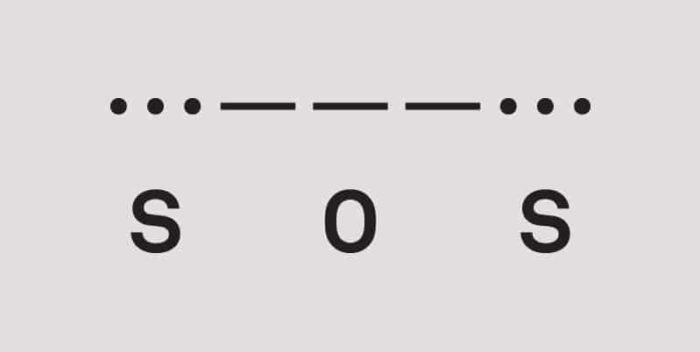
Obviously SOS was developed for Morse Code use, but it’s not the only way the emergency signal has been transmitted historically. The ubiquitous nature of the signal and the fact that it is near universally recognized at this point has allowed it to migrate to other forms of communication. Please keep in mind there are other established methods of signaling for help that are not technically SOS signals. Our guide to distress signals explains many additional methods and how to use them.
Ground Signals
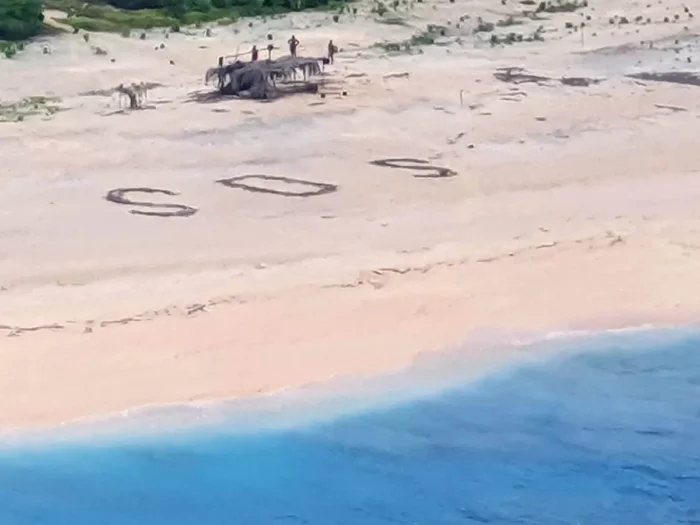
On rare occasions, the act of literally spelling out SOS has been used as a call for aid. This method is actually well used in fiction for the trope of being stranded on a deserted island. People will use sticks or rocks to actually form the letters SOS on a clear beach in the hopes that a passing search plane will see it.
This method works in real life as well. For instance, in 2020, three sailors were found on an uninhabited island near Guam after spelling their SOS on the sandy beach.
Flags
The SOS signal can potentially be spelled out with semaphore flags if necessary. This could be done to signal from ship to shore or ship to ship, though there are other visual flag signals which can be used to indicate distress.
Mirror Signals

Piggybacking off of the SOS Morse Code signal, a signal mirror or other reflective surface can be used to visually represent the code. In this method, a mirror is used to reflect a light source, typically the sun, to a distant observer. The signaller can use their hand to block the light or adjust the direction of the mirror to flash light matching the code in a way that would show three quick flashes, three longer flashes, and three quick flashes again. This mimics the dots and dashes of the Morse signal.
If a mirror is not available this same method can be performed with a flashlight or cell phone light source by blocking the light beam in the SOS pattern.
Sound Signals
Like the use of a mirror, an audio signal can mimic the Morse Code for an SOS. Boats generall have a horn, a bell or both on board to provide sound signals to other vessels. In an emergency if there is no other option available, a bell could be rung or a horn could be sounded in a pattern that duplicates the Morse signal.
How to Send an SOS
When you are on the water and in need of help, ideally you’re going to be able to use your VHF radio to make a proper Mayday or Pan-Pan call. Our guide to getting help on the water covers the proper procedure for making a distress call in an emergency situation.
An SOS as we’ve detailed above would typically only apply when your radio is unusable so a traditional distress call is not an option. However, your best bet is to have equipment on board that can access the Global Maritime Distress and Safety System. Most new VHF radios can automatically connect to this distress system, as can various phone apps you can download or a device such as an EPIRB.
The GMDSS alerts search and rescue anywhere in the world and can provide GPS coordinates to help find your position. Once that has been done, SOS signals such as light, sound or visuals can aid in allowing rescuers to find you faster.
The Bottom Line
The SOS signal was developed over 100 years ago as a universal method of calling for help that could be communicated and understood beyond language barriers. The signal was designed because it is easy to remember and hard to mistake for anything else. It has no inherent meaning beyond a distress signal and the actual letters in Morse Code, SOS, are merely the ones coincidentally attached to the memorable code. As such, SOS doesn’t stand for anything or mean anything.
SOS was replaced in 1999 by the GMDSS as the standard distress call at sea but it is still a useful and recognizable way to call for help through numerous different means, well beyond simple More Code.
Categories: nauticalknowhow
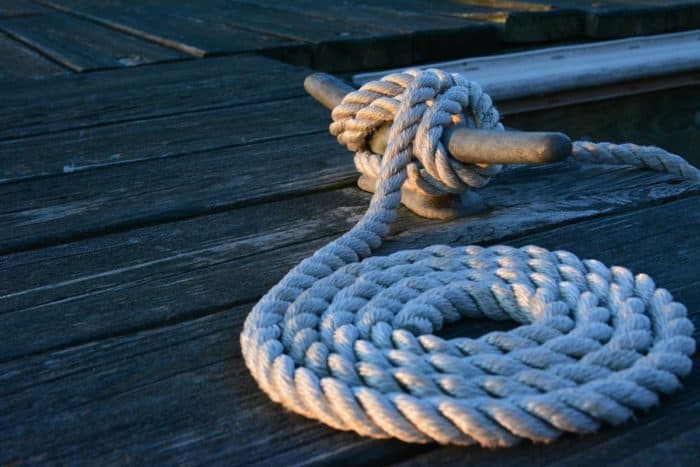
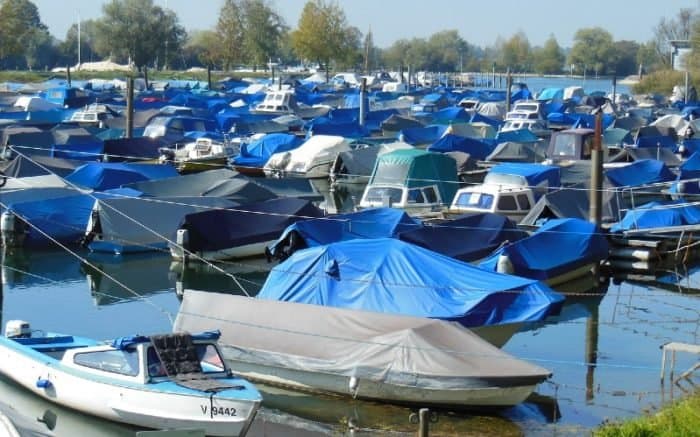
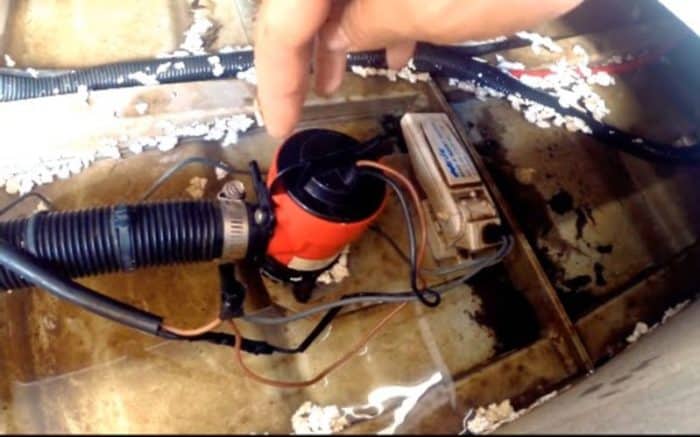






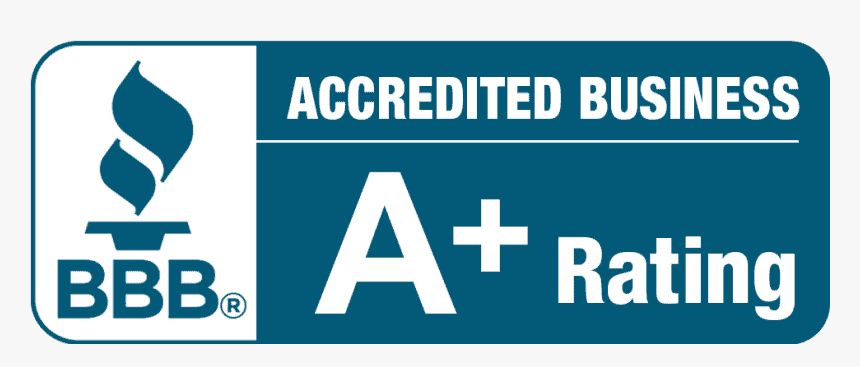


7 Comments
Sean Reardon on October 1, 2019
So what did “CQ” stand for? How did “All Stations” turn into “CQ”?
Thank You.
–Sean R.
Anonymous on August 1, 2020
Land telegraphs had adopted the convention of using “CQ” (“sécu”, from the French word sécurité)[2] to identify alert, or precautionary messages of interest to all stations along a telegraph line. CQ had then been adopted in maritime radiotelegraphy as a “general call” to any ship or land station.
Katrina on April 20, 2022
Come Quick
Kyla on January 9, 2020
Hi my dad is in the army, and I was wondering if he uses the SOS too.
Lucky on January 9, 2020
Hi I have a(n) answer to your question and yes the army does use the SOS
Lucky on January 9, 2020
Yes the army does use the SOS
Larry Strickland on March 23, 2021
The CQ and SOS when received it is unmistakable!